Bees see polarized light and use it to navigate to honey. Learn how you can use it to crack the Egg Nebula.

Emmanuel Boutet / CC BY-SA 3.0
Polarizing. Now there's a word. You might hear it in the context of current politics, but we'll stick to its neutral side as in polarized light. No mudslinging here.
Most of us are familiar with polarization by way of polarized sunglasses, which greatly reduce glare from water, highways, and the sky. How do they work?
Let's start with raw light, which is made of oscillating electric and magnetic waves at right angles to each another moving through space at the speed of light. If you attach one end of a rope to a chair and shake the other end in rhythm, you'll create a lovely rippling wave along its length resembling the oscillating electric field of a light wave. Now imagine that at the same time, you could wiggle the rope perpendicular to the first direction. Then you'd have an alternating series of waves propagating down the rope in synchrony with the first set. Sometimes they're referred to as vibrations. A rope can't do this, but it's no problem for light.
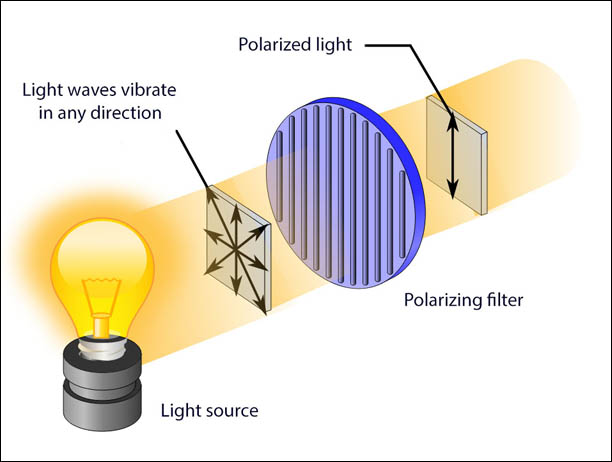
Kaidor / CC BY-3.0 with annotations by the author
Light from the Sun, a candle flame, or a flashlight is made of an assortment of light rays oscillating in many directions around their central axes like a handful of different ropes, each with their wave crests set off at a multitude of angles from one another. We call this light unpolarized. But a funny thing happens on a sunny day. Air molecules centered 90° from the Sun interact with this confused mess of electromagnetic radiation and scatter back to our eyes mostly rays that oscillate in just one direction called polarized light.
We see the result as a washed-out sky. To reduce glare and increase contrast in photos, photographers sometimes use a polarizer or polarizing filter. A polarizer is a piece of glass or plastic coated with long, parallel chains of molecules that resemble a picket fence. You can pick one up at any camera store or online at Amazon.
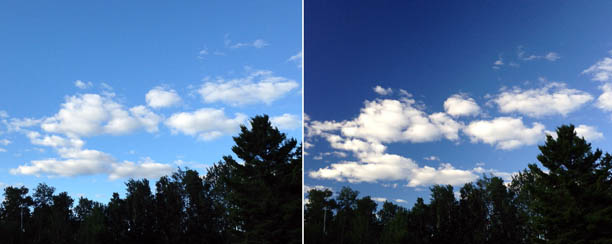
Bob King
If you pivot 90° away from the Sun and rotate the filter in front of your eye, the sky in that direction will darken dramatically because the polarized light, which vibrates in just one direction, can't pass through the molecular "slats". If you continue turning the filter, eventually the gaps in the fence will align with the incoming polarizing light and the sky will lighten back up.
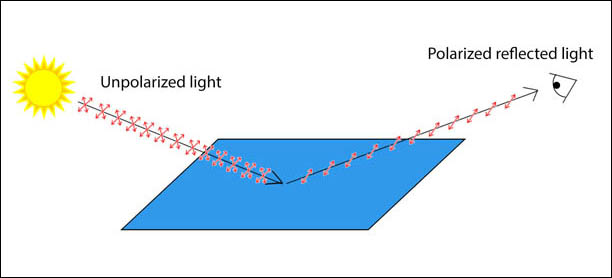
Bob King
Although you can see where skylight is polarized any time of day, the best time is in the early morning, when the Sun is low in the eastern sky, and again in the evening, when it drops into the west. Using a filter, polarization shows as a broad, dark band centered along the north-south meridian and passing through the zenith.
When unpolarized sunlight strikes a lake or an asphalt road (see above), much of it becomes polarized in the same plane as the surface that it hit. Once again, glare is produced. To eliminate it, polarized sunglasses are coated with horizontally-oriented chains of molecules that block and absorb the offending "horizontally-vibrating" light.
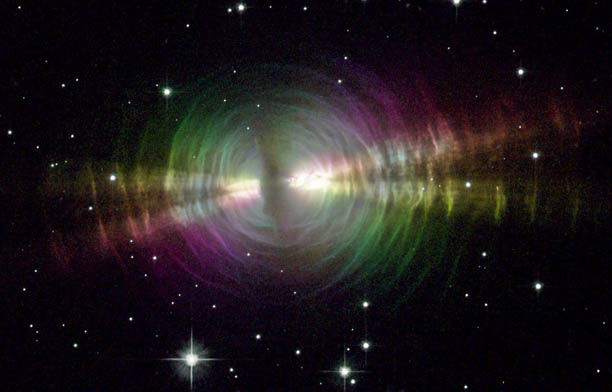
NASA / ESA
Bees, birds, fish, bats, and other animals can sense polarized light and use it for orientation and navigation, proving that sooner or later life finds ways to bend each and every principle of physics towards survival. Astronomers are no different. They exploit polarized light to study, among other things, reflection nebulae. Starlight reflecting from minute particles of dust surrounding stars can become polarized. Carefully scrutiny of the light can tell us the makeup of those dust clouds as well as help us determine a star's location within obscuring nebulosity.
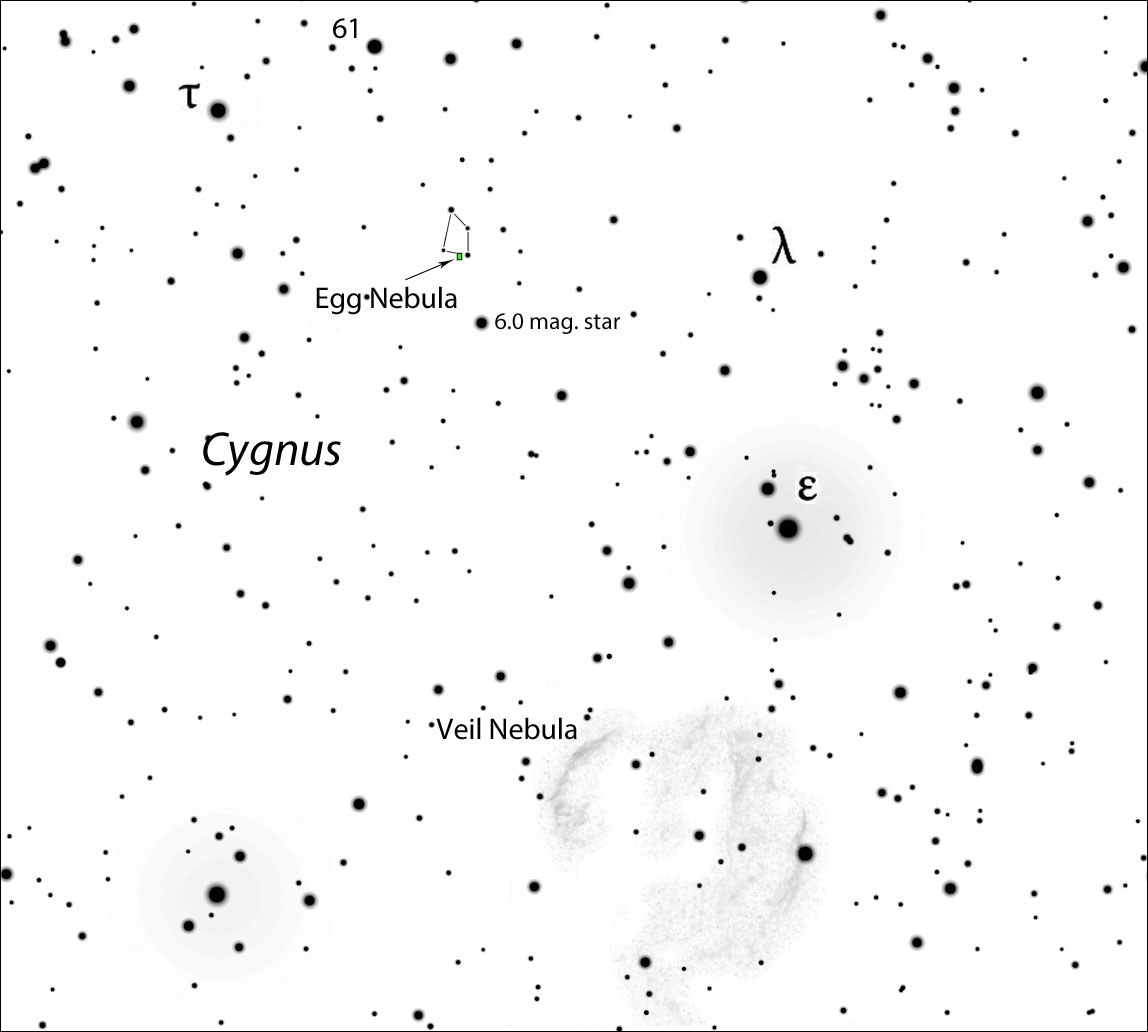
Map: Bob King; Source: Stellarium
I'm aware of just one nebula that's that emits enough polarized light to be obvious in an amateur telescope: the Egg Nebula, also known as PK 80–6.1. It's currently well-placed for evening viewing in Cygnus, not far from the Veil Nebula near Epsilon (ε) Cygni. Several sources list it as magnitude +14, but that's clearly in error. It's much closer to +12 and quite easy to see at a magnification of 64× in my 15-inch reflector with an obvious bipolar shape.
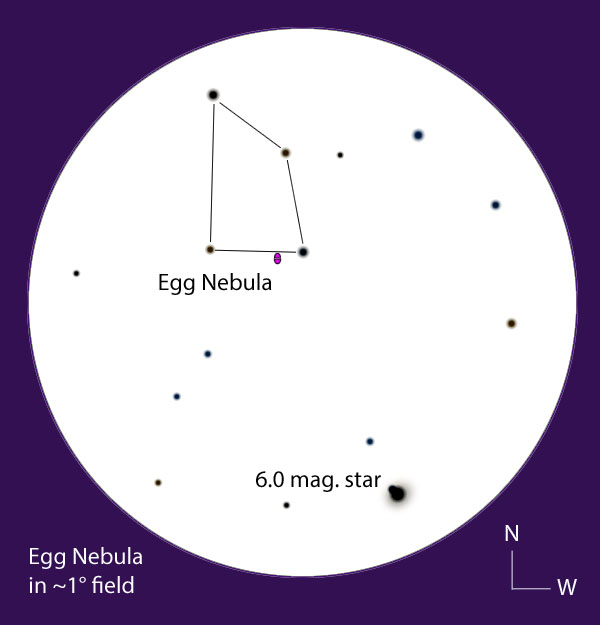
Map: Bob King; Source: Stellarium
Since the Egg measures only 30″ × 15″, it's best at 200× and up, where two fuzzy blobs separated by a narrow dark gap become obvious. The northern blob is clearly brighter with a much brighter, fuzzy central condensation. Within the slice of darkness betwixt the two hides a star that's evolving right before our eyes from red giant to white dwarf as it builds itself a planetary nebula nest.
Using a common linear polarizing filter like the ones sold at telescope shops or camera stores, I placed it between eye and eyepiece and slowly rotated it to see what would happen. The effect was subtle but clear — the brighter lobe changed little, but its partner faded and returned to normal as I turned the filter in a circle. How totally cool to see polarization at work 3,000 light-years from home!
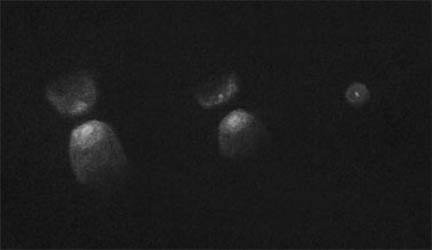
Martin Schoenball
Amateur astronomer Martin Schoenball used a 10-inch scope to make an even more remarkable observation:
"If you hold the filter between the eyepiece and the eye and rotate it, you can see the nebula fading and brightening. If you rotate the filter so that the nebula is damped, most the nebula vanishes nearly completely. If you rotate the filter again by 90°, the nebula is nearly as bright as without a filter! This is astrophysics live!"
And that astrophysics has told astronomers exactly where within that dark disk the aging star churns, as well as the composition of those gorgeous dust shells: mostly carbon. Carbon created in the deep within the star's core and now ejected into space ready to be swept up someday to make new stars and planets. Living things, too?
For a fun, interactive sketch of the Egg made through an 8-inch telescope with and without a polarizer, visit Jeremy Perez's The Belt of Venus. Now it's time for you to crack the Egg. Let us know how you do.
 8
8
Comments
Antonio Mario
August 26, 2016 at 5:40 pm
Hi Bob, thanks for the interesting article!
A quick comment on your remark about polarized sunglasses having vertically-oriented molecules (to cut reflections from asphalt). Actually, those molecules are horizontally-oriented (!). Electrons will then be also more free to move horizontally and hence absorb more that polarization. Vertical polarization will then pass through more easily.
I've been meaning to give it a shot at the Egg Nebula for quite some time now. Quite a bit North (some 60deg when on the meridian for me) but I'll try.
Thanks.
You must be logged in to post a comment.
Bob KingPost Author
August 27, 2016 at 11:44 pm
Thank you Antonio - you are correct! Thank you for noticing the slip. Now corrected. You'll enjoy the Egg Nebula - I hope you have the opportunity to see it.
You must be logged in to post a comment.
Antonio Mario
September 2, 2016 at 7:29 pm
Thanks again, Bob, for a nice piece. Great educational value. I've propagated it to some pages on FB that I'm connected to.
And let's have more polarization articles on S&T!
Best.
You must be logged in to post a comment.
Bob KingPost Author
September 4, 2016 at 10:37 am
Thank you, Antonio. I'm glad you found it information and appreciate you writing.
You must be logged in to post a comment.
SNH
August 29, 2016 at 3:23 pm
Hey,
I have two polarizing filters each with a 30% transmission that I use for when looking at the moon. Will those by chance work on your deliciously exciting object!?!
You must be logged in to post a comment.
Bob KingPost Author
August 29, 2016 at 7:33 pm
Hi SNH,
Yes, just use one and rotate away. Let us know if you can detect polarization. Good luck!
You must be logged in to post a comment.
Walter Clayton
September 3, 2016 at 5:47 pm
I took a look at this with my 10in using an 8.8mm 2in Meade eyepiece. we were at our dark sky site near Ludowici, Ga which is pretty dark, but, not, like out in the desert dark. It was VERY humid though. We had some clouds move through during the evening, but, we did get some nice viewing in.
I did see the nebula. I put my polarized filer in and found that if I turned the eyepiece, the nebula did change. What I found interesting was that as I turned, the nebula faded but became more of a point source.
WAC
You must be logged in to post a comment.
Bob KingPost Author
September 4, 2016 at 10:38 am
Walter, thank you for sharing your observation. I hope it encourages others to see if they can detect polarization, too.
You must be logged in to post a comment.
You must be logged in to post a comment.